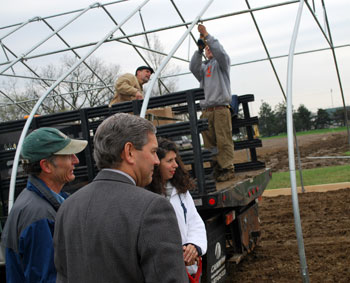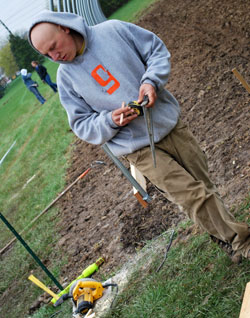St. Joe’s Plows Ahead with Local Food
Head north on Hewitt Road from Washtenaw Avenue, past Eastern Michigan’s Rynearson Stadium to the edge of the St. Joseph Mercy Hospital campus. Off to the right is a plot of land that the health provider is now returning to a previous use – farming.

Hank Beekley with his team of draft horses – a Belgian and a Shire – disks the field. The hospital building is visible in the background. The view is roughly to the northwest. (Photos by the writer.)
The centerpiece of the current effort is a 30 x 96-foot hoop house, which began construction on Monday. It will be joined by a second hoop house later in the summer, and plans call for a dozen of the structures to be built in the coming years.
The vegetables grown on the plot will be used in the hospital cafeteria and patient meals, and sold at a farmers market, with excess donated to Food Gatherers.
On Monday and again on Wednesday this week, Hank Beekley and his team of draft horses helped with the effort to transform about an acre of St. Joseph’s 356-acre campus in Superior Township to productive farming.
Tuesday was an off day for the horses – wet conditions were the key factor. But Beekley himself was there on Tuesday, along with other volunteers and St. Joseph’s staff to help build the first hoop house, which was already off to a good start based on Monday’s work.
Hoop House Construction
Overseeing the hoop house construction on Tuesday was Dave Raymond, who is St. Joseph’s service delivery leader for planning.

The skeleton of the hoop house had taken shape by Tuesday morning on the campus of St. Joseph Mercy Hospital in Superior Township.
He explained that the pieces of untreated lumber affixed to the bottom of the metal pipe ribs are skirt boards – that’s where the plastic covering will be attached. It will be a double-Visqueen covering, he explained, with the design allowing for the plastic to be rolled up for venting.
Without the ability to vent, Raymond said, the temperatures inside the hoop house during summer weather would easily reach 140 degrees. That kind of solar gain, however, is what will allow the hoop houses to produce vegetables year round, even through the winter. In addition to protection from the exterior walls of the hoop house, additional row covers might be required for the most extreme cold, he said.
Raymond confirmed that the structure is engineered to withstand a snow load. Part of that strength will come from the purlins that were being installed on Tuesday morning. Purlins are the horizontal members that join the ribs of the structure and provide lateral stability.
What’s the Investment?
Each hoop house, said Raymond, reflects about a $10,000 investment, or $120,000 for the 12 hoop houses that are eventually planned. On Tuesday morning, Raymond told The Chronicle that he expects the total investment to break even in around three years.

In the foreground is St. Joseph Mercy CEO Rob Casalou. Left (in the green cap) is Dave Raymond, who is overseeing hoop house construction. Right (white jacket) is Lisa McDowell, head of nutrition at St. Joseph. On the flatbed truck attaching purlins are Mike Score and J.P. Swanson.
The projected return factors in (i) the cost savings of not mowing the area, (ii) the cost savings from using the vegetables grown in the hoop houses in the hospital cafeteria and for patient meals, and (iii) proceeds from the sale of the vegetables at a farmers market to be run two days a week at the hospital.
But Rob Casalou, CEO and president of St. Joseph Mercy, said Tuesday that he has not given the project a time period to show a financial return. The commitment is based on the fact that it’s a good idea, he said – that the hospital is not just a place where people go and get fixed, but rather it provides support for overall wellness. Besides Raymond, Casalou gave credit to two others for moving the hoop house project forward: Lisa McDowell, who is head of nutrition for St. Joseph Mercy, and Dr. Steve Thiry, a St. Joseph Mercy physician.
The Wellness Angle: Fruit, Bees, Syrup
Lisa McDowell, head of nutrition at St. Joseph Mercy, spent part of Tuesday morning wielding a shovel. But she also took time to tell The Chronicle that besides the 12 hoop houses and the exterior garden space, there are also plans to add fruit trees: pear, apple, peach and plum. They’re also thinking of adding some bee colonies, and tapping the numerous maple trees on the property to make maple syrup.
McDowell ballparked the number of meals served at St. Joseph Mercy at more than 3,000 a day. And according to Dave Raymond, they’d need 12 hoop houses just to provide all the lettuce. But it’s planned as more than just a symbolic effort – his estimated three-year payback on the investment is consistent with that idea.
McDowell also put the hoop house project in the context of the Health Care Without Harm (HCWH) initiative, which St. Joseph Mercy has signed. From HCWH’s website:
HCWH is committed to driving the green revolution in healthcare, making the connection between good health and a clean environment, and positioning healthcare’s core principle of “first, do no harm” as a central pillar of sustainable society.

Mike Score, president of Hantz Farms in Detroit and former Michigan State University Extension educator for Washtenaw County, helps attach purlins.







Wonderful article, Dave. It’s great to see St. Joe’s modeling such good stewardship of the land they own. I’m proud my daughter was born there!
This is just a great story (well-reported, but I’m referring to what St. Joe’s is doing).
These kinds of spontaneous efforts give me hope.
Kudos to St. Joes!
The Ecology Center has been very active in the healthy food in health care area – [link]
I was very happy to hear about this initiative. I spent one night at St. Joe’s in 2008 after giving birth to my daughter Sylvia. We received excellent care during our stay – especially from the fabulous nurses.
The only complaint we left on our comment card? They were serving apple juice imported from China. I understand the need for health care institutions to keep costs low, but I have to think that one of our Michigan apple juice producers could fufill St. Joe’s juice needs at a reasonable cost.
Way to go St. Joe’s! This is not just a socially responsible action, but a financially smart move. More hospitals will follow suit and St. Joe’s can be proud to have been a leader. I also believe they are the only hospital in MI to have signed on to the Health Care Without Harm (HCWH) initiative.
Denise,
Actually Bronson Medical Center in Kalamazoo was the first Michigan hospital to sign on to the Health Care Without Harm pledge.
Vivienne, I know you really didn’t mean “spontaneous” – perhaps unexpected? – as there was nothing spontaneous about the planning that went into this event or the anticipated future benefits to the entire community from this example of a health care institution putting emphasis on creating health versus treatment of disease.
I agree that this effort is hopeful, so much so that I will always now look at “hoop houses” as “hope houses”. :-)
Hi Denise and Diana and all others interested!
I am very happy to share that I am the Healthy Food in Health Care Coordinator for the Ecology Center and I actively work with many hospitals in the state working to serve healthier food to their patients, staff and communities!! To date these are the ones that have signed Health Care Without Harm’s Healthy Food Pledge: Bronson Methodist Hospital, Sparrow Hospital, Northern Michigan Regional Hospital, Borgess Health, Metro Health Hospital, Chelsea Community Hospital, Henry Ford West Bloomfield Hospital, St. Joseph Mercy Hospital, and Immaculate Heart of Mary.
You can take action too!: It’s great for all of you to tell your hospitals you would like them to serve local and/or organic foods.
Cheers!
Hmmm, what did I mean by “spontaneous”? Obviously a lot of work and planning went into the effort.
Maybe I meant an effort that is clearly initiated by an individual institution (and many of its officials and volunteers), a “bubble-up” effort, rather than a response to some regulatory or other governmental directive.
Or maybe I just meant that I was surprised to see such a full-fleshed program “suddenly” appear.
Regardless, it was very good news.
This is fantastic news!
Excellent Idea. Way to go St Joe!
Thank you for putting patients first!!
Are you really using Visqueen as a covering? Visqueen won’t withstand UV rays. Tufflite is a better choice, or a poly woven covering. Just trying to help. The project sounds great, I can’t wait to see how it does and maybe tour it someday.
This is fantastic! I have renewed respect for St. Joes! Now how do we get U of M to follow suit?
Fantastic — long over due — but happening — wonderful news — Barbara O’donnell
Kudos to SJMH! and to Dave Raymond and Mike Score – Two men of great vision for the future – linking service, nutrition, business, and agricultural development of Michigan in this unique and exciting project